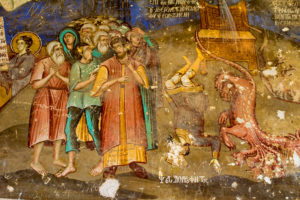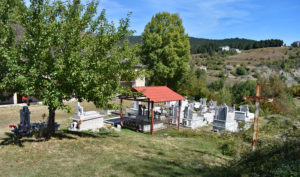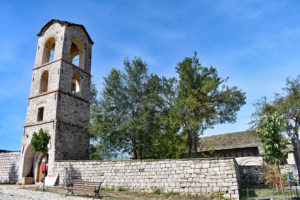Whilst staying in “Korça”:https://www.silvertraveladvisor.com/review/attraction/200720-review-sight-seeing-in-kor-a, in south east Albania, we visited the village of Voskopoja. On the map, it looked a fairly straight road, but in reality, was a very bendy, uphill journey and took around 35 minutes to do the 20km.
The village was once the largest city in the entire region and, with a population of 35,000, was bigger than Athens and Sofia, with its early growth due to its proximity to three rivers. In early years an artistic academy developed where artists produced the many frescos for Voskopoja’s 24 churches and 4 basilicas, as well as those in the surrounding area. Such fame had a price and the town was ransacked and burned in 1769, 1772 and 1789. Eventually in 1916 after unrest in the Balkans, it was replaced in importance by the newly developing Korça. It is hard to imagine that this small, remote, village of a few hundred was once so grand. Of the churches only seven remain, and many are in a poor state.
On arrival, the modern visitors’ centre, wasn’t open. We met our guide, a young lady called Angela who would take us around the four churches marked 2,3, 4 and 6 on the map. She outlined the usual structure of an Eastern Orthodox Church which would be divided into three parts: the narthex or vestibule for those not confirmed, the nave or main body, and the sanctuary or alter which only priests are allowed into. A wooden iconostasis, or wall of religious icons, separates the nave from the sanctuary. Outside would have been a covered arch or portico and a bell tower.
CHURCH OF ST NICHOLAS – We walked to the first church and although having seen many cars parked as it was a Sunday, it was very quiet. This is the only church fully intact and regular services are held. It was built over 10 months in 1721. We walked around the portico and bell tower which Angela charmingly referred to as a ring tower. In the nave, the first level frescoes featured the saints and the apocalypse was on the second. The frescoes of new and old testament miracles were very dark as they’d been affected by humidity. During the communist era when religion was banned, this church was locked up but, as it was designated a monument of culture, it was not defaced. Here we saw St Christopher with a dog head under an arch and were told this is the only place where this occurs but sadly photos were not allowed. However, we later saw an icon of this in the National Museum of Medieval Art in Korça and were able to photograph it here.
CHURCH OF THE ARCHANGELS – This was built in 1723 and had three domes, representing the Holy Trinity, with circular floor mosaics under each. The portico was destroyed in the 1996 earthquake. Inside, the only original features were the frescoes as the iconostasis was new. Two of the frescoes of the archangels had their halos in relief and were original. During the communist era, this church was used as storage for the military. Whilst we were looking at the graves of two priests, Angela noticed bees going into a tiny hole in the brick and took photos to report the damage being caused.
We drove to the next two churches.
CHURCH OF ST ATHANONSIOS OR IGNATIUS – This somewhat isolated church, built in 1724, functions today as the Voskopoja Cemetery Church. The graffiti on the portico had been done at various stages over time. The narthex was destroyed by bombs during World War 2 and some of the frescoes had been damaged by guns during 1997, but one showed King Herod drowning babies. Here we were allowed to take two, non-flash photos. During the communist era this church stored potatoes.
CHURCH OF THE DORMITION OF THE HOLY VIRGIN – This was the earliest of all the churches we saw, being built during 1669. It was the biggest and most important church in the old city. The nave and narthex were bombed during World War 2 and the portico destroyed during an earthquake in 1960. Two small chapels had also been destroyed. The bell tower was not from the same era and the frescoes were not completed until 12 years after the church had been built. The carvings around the iconostasis were original but the second icon to the left should have been Mary (it’s always connected with the name of the church). Instead it was of two brothers, as it was the only one available to the priest. This church was used to store guns during the communist era.
None of the churches have UNESCO status and funding for restoration is therefore limited. We saw on a hillside, piles of stones which would have been part of the old city, but again funds are not available to fund digging. Everything is free and I asked whether they had thought of charging, which Angela said they had in the past. It must be galling for them to see money wasted on the “”toothbrush tower”.”:https://www.silvertraveladvisor.com/review/attraction/200739-review-voskopoja










